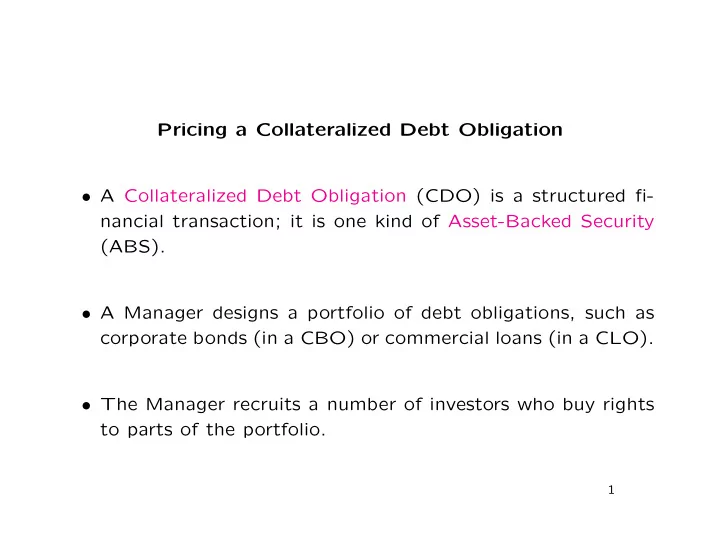

Pricing a Collateralized Debt Obligation • A Collateralized Debt Obligation (CDO) is a structured fi- nancial transaction; it is one kind of Asset-Backed Security (ABS). • A Manager designs a portfolio of debt obligations, such as corporate bonds (in a CBO) or commercial loans (in a CLO). • The Manager recruits a number of investors who buy rights to parts of the portfolio. 1
• Each investor buys the right to receive certain cash flows derived from the portfolio, divided into tranches . • The senior tranche has first call on the cash flows (interest and principal), up to a set percentage. • The junior tranche has next call, again up to a set percent- age. • Remaining cash flows are passed through to the equity tranche . 2
• Simplified example: suppose that the portfolio consists of two corporate bonds, B 1 and B 2 , and neither pays interest. • The bonds are priced at b 1 and b 2 at t = 0. • Each bond returns 1 at t = T if its issuer is not in default, and 0 if the issuer has defaulted. • The matrix D is: In default: Neither Issuer 1 Issuer 2 Both e rT e rT e rT e rT Cash 1 0 1 0 B 1 1 1 0 0 B 2 3
• D is 3 × 4, so N = 3 < n = 4, and the market is not complete. • Now 1 S 0 = b 1 . b 2 • If 0 < b i < e − rT , i = 1 , 2, then S 0 = D ψ where (1 − p 1 ) (1 − p 2 ) p 1 (1 − p 2 ) ψ = e − rT (1 − p 1 ) p 2 p 1 p 2 and p i = 1 − e rT b i , i = 1 , 2. 4
• Clearly ψ is a state price vector, and the corresponding risk- neutral measure Q implies that the probabilities of default are p 1 and p 2 . • It also implies independence of the events of default. • But because the market is not complete, other state price vectors and other risk-neutral measures exist. 5
• Suppose that the CDO has just a senior tranche S and the equity tranche E , and each receives 50% of the cash flows (which are only the return of principal at t = T ). • With these added to the market, D becomes In default: Neither Issuer 1 Issuer 2 Both e rT e rT e rT e rT Cash 1 0 1 0 B 1 1 1 0 0 B 2 1 1 1 0 S 1 0 0 0 E 6
• Actually, one of S and E is redundant, because S + E = B 1 + B 2 . For convenience, we drop E . • If the senior tranche has price s at t = 0, we find b 1 + b 2 − s s − b 1 ψ = D − 1 S 0 = . s − b 2 e − rT − s • For the market to be arbitrage-free, we must have � � e − rT , b 1 + b 2 max( b 1 , b 2 ) < s < min . • Note that seniority means that S costs more than either bond. 7
• If Q s [ · ] is the corresponding risk-neutral measure, we find that the probability of default of issuer 1 is e rT � � s − b 1 + e − rT − s = 1 − e rT b 1 = p 1 , as before, and similarly p 2 for issuer 2. • But the probability that they both default is 1 − se rT , and this equals p 1 p 2 only when s = b 1 + b 2 − e rT b 1 b 2 . • Typically, s < b 1 + b 2 − e rT b 1 b 2 , which means that the prob- ability of both issuers defaulting is higher than it would be under independence. 8
• In this case, there is positive dependence between the events of default. • Dependence is often modeled using a Gaussian copula . • Suppose that default is associated with random variables Z 1 and Z 2 , normally distributed with mean 0 and variance 1, and correlation ρ . • Issuer 1 defaults if and only if Z 1 < Φ − 1 ( p 1 ), and similarly issuer 2. 9
• The probability that both default is a function of ρ . • If ρ = 0, events of default are independent. • The value of ρ that corresponds to the risk-neutral probability of both issuers defaulting is the implied correlation . 10
Recommend
More recommend